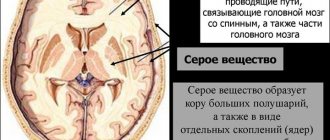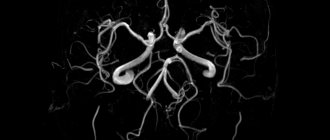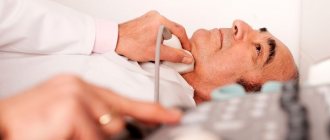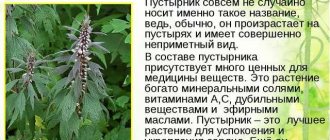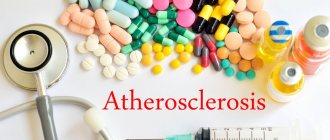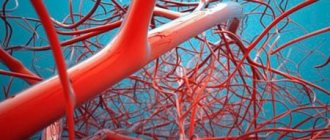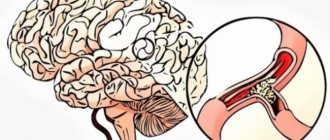+RU
Consultation with a Phlebologist in Moscow, Articles, Reviews of Clinics
Join us and follow the news on social networks
Diseases of the heart muscle not only cause discomfort to a person, but also pose a serious threat to life. Thus, vasospastic angina, accompanied by a sharp and often sudden narrowing of the arteries supplying the heart, can cause acute coronary syndrome and even provoke the development of myocardial infarction.
What are the symptoms of coronary vasospasm, why does it occur, and how to avoid its development? You will find answers to these questions in our review and video in this article.
Sudden pain in the heart (usually at night) is a possible sign of coronary artery spasm
- The essence of the problem
- Clinical manifestations
- How to diagnose the disease
- Current treatment approaches Non-drug methods
- The most effective drugs for stopping an attack
- Surgical techniques
Development mechanism
The basis of cerebral vascular spasm is a violation of neurohumoral regulation. Imbalance of mediators and dysfunction of calcium channels negatively affect the autonomic nervous system, which regulates vascular tone. During an attack, arteries and smaller cerebral vessels contract, and accordingly, blood flow slows down and the brain experiences oxygen starvation. As a result, characteristic symptoms appear, which can be reversible or irreversible.
In the first case, the spasm passes without consequences, in the second it is fraught with strokes, encephalopathy, and aneurysm rupture (especially in the presence of blood clots and atherosclerotic plaques).
Prolonged vasospasm during pregnancy can lead to eclampsia, a severe form of gestosis.
Why does vasospasm occur?
Spasm of cerebral vessels can be caused by various reasons. Among them, the most common are the following conditions and pathologies:
- hypertension, atherosclerosis, heart failure;
- congenital anomalies of the vascular wall;
- systemic connective tissue diseases, brain tumors;
- TBI, acute circulatory disorders - strokes;
- neuroses, migraines;
- osteochondrosis of the spine in the neck;
- infections – encephalitis, meningitis;
- liver and kidney diseases;
- birth injuries in newborns.
Persons who abuse alcohol, smoke, or take drugs are also at risk. Due to improper nutrition (overeating, consuming large amounts of fats with quickly digestible carbohydrates), lipid metabolism is disrupted, diabetes and obesity develop.
Angiospasms often occur in mentally unstable people, as well as as a result of psycho-emotional stress. The risk of vascular spasm increases if there is a family history of cerebrovascular diseases, hypertension, and migraines.
Symptoms
Due to a sharp narrowing of the vascular lumen, blood flow to the brain decreases, and characteristic signs of cerebral vascular spasm appear. First, a diffuse “squeezing” headache occurs, radiating to the eye sockets. Often an attack begins after physical stress, a sleepless night, or stress. Weather dependent people react to weather changes this way. In addition to painful sensations, dizziness and nausea (even attacks of vomiting) appear. Cognitive functions are depressed, noise appears in the ears, and spots appear in front of the eyes.
The latter phenomenon is caused by circulatory disorders in the ophthalmic artery associated with the cerebral ones. Therefore, with vasospasm, the tone of the eye muscles changes and the blood supply to the retina deteriorates. Due to this, the patient cannot focus his vision and complains of darkening and flickering of black dots before the eyes. In addition, dysfunction of the autonomic nervous system negatively affects the condition of the blood vessels of the whole body: pressure increases or decreases, sweating increases, the face turns red, and sweating increases.
Coronary vessels - what are they?
All organs in the body are interconnected by a web of the circulatory system, which includes:
- Arterial branch - supplies the heart, brain, kidneys, liver and other systems with blood saturated with oxygen and nutrients.
- The venous branch is a channel through which blood flows with waste products and carbon dioxide, allowing the disposal of unnecessary waste from the body.
The diameter of both branches is varied, the further from the heart, the smaller their size - capillaries, postcapillaries, precapillaries, arterioles, arteries, veins. Each vessel has a lumen that is lined with smooth muscle, which helps the blood flow to move at a certain speed.
The direction of flow through the veins and arteries is opposite; blood flows to the heart through the arterial branch, and from the heart through the venous canal.
Coronary vessels are large arteries that carry blood to the heart and brain. If a sharp spasm occurs in a coronary vessel, a person feels pain of varying intensity in the heart or head, which depends on the location of the spasm. In this case, the blood circulation process is disrupted, because the fluid moves in a circle and any obstacle slows it down.
Consequences
Vascular spasm can be both a cause and a consequence of acute cerebrovascular accidents - hemorrhagic stroke, rupture of an aneurysm. In case of intense pain, loss of consciousness, impaired coordination, speech, you should immediately seek medical help.
A prolonged attack can lead to ischemic stroke with death of brain tissue and disability. In children, prolonged vasospasms can cause further delays in mental development, and in pregnant women - eclampsia. This condition is considered the most severe form of gestosis, fraught with coma, pulmonary edema, and fetal death.
What does a person feel?
Symptoms of coronary spasm appear unexpectedly and regardless of physical or emotional stress. The coronary vessel narrows to varying degrees, which affects symptoms.
The following clinical picture is often observed:
- Sharp pain behind the chest. The strength of the pain forces a person to intuitively place his hand on the source of the spasm. The attack lasts 20 minutes or more.
- The pain spreads to the shoulder blade and left arm.
- Fear, panic state.
- A person reduces activity and may stop completely, not wanting a repeat attack of pain.
- Increased heart rate.
- Reduced blood pressure.
- Cold sweat appears.
- A feeling of coldness in the arms and legs due to a malfunction of the heart and slow blood flow in the peripheral vessels. Sometimes a short-term cramp occurs.
- There is a feeling of lack of oxygen, it is difficult to breathe.
- Discomfort from the gastrointestinal tract.
Dizziness and headache are symptoms of vasospasm in the cerebral (coronary) vessels. With a prolonged attack, signs of confusion and incoherent speech are possible, somewhat similar to a stroke.
Diagnostics
The primary diagnosis is made by a therapist or neurologist based on clinical signs and their dynamics, blood pressure measurements, and information about existing diseases. After first aid is provided, a number of instrumental studies are carried out:
- MRI of the head and neck;
- angiography with the introduction of a contrast agent;
- ultrasound diagnostics of cerebral vessels;
- CT angiography;
- Dopplerography.
During diagnosis, cerebral vascular spasm is differentiated from cerebrovascular pathologies with similar symptoms. These include transient ischemic attack, strokes of both types, hydrocephalus (acutely developing with a tumor), and other liquorodynamic disorders.
How to diagnose the disease
In diagnosing the disease, a conversation with the patient plays an important role, during which it is necessary to find out the intensity, location, nature and conditions of pain. Using this data, the doctor will be able to predict the possible causes and consequences of angina, draw up a diagnostic plan and prescribe appropriate treatment for the disease.
In addition, standard instructions for examining patients include the following laboratory and instrumental tests:
- general clinical tests of urine and blood;
- biochemical blood test - determination of electrolytes, total cholesterol and lipoproteins, alkaline phosphatase and transaminases (ALT, AST);
- cardiac troponins markers T and I – indicate necrosis (irreversible damage) of myocardial cells;
- electrocardiography – there is a decrease in the ST interval at the peak of the attack;
- Echocardiography – local ischemic changes are determined;
- bicycle ergometry - is carried out to determine the maximum physical load that can be withstood by the patient without disrupting the supply of oxygen and nutrients to the heart muscle;
- coronary angiography - prescribed to assess the location, extent and extent of damage to the coronary arteries.
Note! As a rule, patients suffering from spasms of the heart arteries note a certain rhythm during the course of the disease: angina pain develops at the same frequency, for example, once a day, once a week or once a month.
Outside of attacks, in patients with classic Prinzmetal angina, objective signs of impaired blood flow in the heart muscle are not observed. Often the patient's complaints are the only thing the doctor has to rely on. In this case, the diagnosis can be confirmed using daily ECG monitoring.
Treatment
A mild spasm can be stopped quite quickly on your own at home. To relieve an attack, you must first provide a flow of fresh air. It is advisable to take a horizontal position and place a pillow under your head.
It is recommended to drink a glass of heated water and keep your feet cool for a short time. Self-massage relieves symptoms of vasospasm well. If attacks recur frequently or their manifestations are severe, you should definitely consult a doctor and start treatment.
Medicines
Drug therapy in this case is complex. To relieve an attack, mild sedatives and antispasmodics are used. In the future, etiotropic treatment is prescribed, including drugs of various groups:
- Antidepressants (Amitriptyline, Azafen) are indicated to stabilize the emotional state, since attacks often occur against a background of increased anxiety and panic attacks.
- Nootropics Nootropil, Piracetam are intended to stimulate cognitive functions and mental activity.
- Calcium channel blockers (Anipamil, Cinnarizine) have an anti-ischemic, vasodilating effect.
- Tablets that improve blood circulation - Vinpocetine, Cerebrolysin, Cavinton.
- Antispasmodics – Drotaverine or No-shpa.
- Sedatives – valerian, motherwort.
In the presence of atherosclerosis, infections, hypertension, appropriate drug therapy is carried out in parallel.
Massage
To relieve spasm of cerebral vessels, you can use self-massage techniques. By pressing on certain areas of the head, you can reduce pain, restore normal blood flow, and reduce pressure. It is recommended to do massage at least 5 times a day to prevent recurrent attacks. You need to work on special points quite intensively, massaging them in a circle until they become slightly red.
The necessary places are localized at the top of the frontal tubercle, in the center of the hairline above the forehead, on the top of the head. It is also useful to massage paired points in the area of the mastoid processes (under the earlobe), near the inner corners of the eyes on the bridge of the nose, on the break of the eyebrow and under the occipital protuberances. It is advisable to knead the collar area to stimulate blood circulation. During self-massage, the eyes should be closed.
Gymnastics
If there are no specific contraindications, you must perform a set of exercises daily to normalize blood flow. It restores muscle and vascular tone, improves memory, coordination and does not give side effects like pills. Gymnastics is especially useful for osteochondrosis of the cervical spine, which is often the cause of vasospasm.
The standard set of movements includes:
- Tilt the head left and right, as well as back and forth while standing. It is advisable to perform them with maximum amplitude, but without pain.
- Turn the head alternately to the sides. In this case, you need to try to keep your shoulder and chin on the same line.
- Raising the shoulders and then moving them back. It is also performed while standing, with your arms hanging freely.
- Shoulder rotation (back and forth).
You need to practice starting from a few minutes a day, gradually increasing the duration of the session. If pain or other symptoms of cerebral vasospasm occur, training should be stopped. All movements are performed smoothly, without haste or sudden movements. While doing the exercises, you need to breathe deeply to ensure a sufficient flow of oxygen. In addition, there are special breathing exercises that help relieve vascular spasm and normalize blood circulation.
Tablets for headaches and cerebral spasms
Cerebral vasospasm refers to a short-term disorder of cerebral circulatory function. The disease manifests itself suddenly, with the muscle layer of the vascular wall contracting, which reduces their lumen and the intensity of blood flow. This condition threatens headaches and possible partial loss of brain function.
The consequences of the pathology are a decrease in the speed and intensity of blood flow, a decrease in the amount of circulating oxygen-rich blood, which leads to disruption of the functioning of nerve cells. As a result, partial loss of brain function or even a stroke may occur. The latter develops against the background of other brain pathologies, for example, atherosclerosis and inflammation. If attacks develop continuously, you should consult a doctor for treatment.
What symptoms might there be?
Spasm of cerebral vessels can occur in four ways:
- purely cerebral variant - symptoms of spasm of only cerebral vessels (60% of cases).
- coronary-cerebral - a combination of cerebral and symptoms of spasm of the cardiac arteries (a common type of disorder - 25%);
- hepatocerebral and pancreatocerebral - simultaneous symptoms of hepatic or pancreatic colic with cerebral colic.
- renocerebral type – renal colic and cerebral vasospasm.
Spasm of cerebral vessels is a sudden attack against the background of complete well-being, disrupting the general condition to varying degrees. The table shows the symptoms of cerebral vasospasm depending on the severity:
- visual impairment;
- slurred speech;
- limb weakness;
- movement coordination disorders.
- puffiness of the face;
- swelling of the eyelids;
- lack of speech;
- signs of severe weakness in the arms and legs.
The first stage has fairly typical symptoms for diagnosis, especially when compared with possible causative factors. The second and third must be differentiated from transient ischemic attack and stroke, although in general the drugs for the treatment of all these diseases are practically the same.
Spasm of cerebral vessels can occur in four ways:
The importance of the regimen in treatment
It is always difficult to be treated with medications alone. They must be taken under certain conditions, the correct dosage, and carried with you to work. At the same time, you should clearly understand that the best pills will not help if you continue to sleep in fits and starts, smoke, and experience nervous overload every day, which is “relieved” by alcohol.
Every person who cares about their health has a negative attitude towards bad habits and relies not on medications, but on their own willpower.
Help improve your sleep:
- daily walks in any weather outdoors;
- control over the ventilation of home and work areas;
- herbal teas in the evening with lemon balm, mint and honey.
In work mode, you need to provide short breaks of 10–15 minutes with a short physical warm-up.
You should relax through exercise, yoga, self-massage, warm showers or sea salt baths. You can try psychological trainings by G.N. Sytin, a famous psychotherapist. He calls them “moods,” precisely formulated orders to himself. You can select the desired “mood” and listen to it while simultaneously viewing pictures on the Internet. It will take no more than 20 minutes a day. The action implies assistance in mastering the auto-training technique.
Strength training is not recommended for frequent headaches. You can ride a bike, go to the pool.
It is necessary to add elements of art to your vacation (listening to classical music, attending concerts, exhibitions, the theater).
The combined drug Andipal combines pain relief and the elimination of spasms, since it includes Analgin, Dibazol and Papaverine in working dosages.
Emergency assistance for vascular spasm
The main treatment can only be prescribed by a doctor after a comprehensive examination and determination of the main cause of the pathology. If this is the first time you have felt these signs, then it is important to know how to relieve spasm of the blood vessels in the head yourself. To do this you should:
- Take a horizontal position and relax.
- Ventilate the room you are in.
- Wash with cold water.
- Do a self-massage: rub your forehead, temples, neck.
Don't miss useful recommendations about self-massage from Dr. Kolpakov:
- Drink a glass of warm water with honey dissolved in it.
- If the pain appears after hypothermia, then you need to take a warm bath.
- 30-50 grams of good cognac will help dilate blood vessels.
- Take advantage of aromatherapy. The use of lavender or valerian essential oils showed good results.
- Aspirin or Ibuprofen tablets help relieve headaches.
If the pain does not go away after this, you should immediately seek medical help.
- "Papaverine" or "Euphelin". They are used to quickly relieve spasms and can only be used under medical supervision.
- Valerian extract. The medicine not only has a sedative effect, but is also able to relieve vascular spasms.
Prevention
Angiospasm of cerebral vessels is a common transient disorder of cerebral circulation. Most often, it is caused by an irresponsible attitude towards one's own health. Therefore, in most cases, this cerebrovascular disorder can be prevented if we are not talking about congenital anomalies, various neoplasms or accidental injuries. A healthy lifestyle will help maintain normal vascular tone, first of all, quitting smoking and other bad habits. Excessive doses of alcohol and nicotine have an extremely negative effect on blood circulation.
You definitely need to move more, exercise, and walk. Physical activity has a positive effect not only on muscles and blood vessels, but also on the nervous system. This way you can avoid the unpleasant consequences of stress. All somatic, neurological, and infectious diseases must be treated in a timely manner, preventing them from becoming chronic.
Since the main causes of cerebral vasospasm are hypertension with atherosclerosis, their prevention is also mandatory. In addition to the methods listed above, you should adhere to the principles of a healthy diet. Very often, it is an unbalanced diet that leads to excess cholesterol in the blood, obesity, and arterial hypertension. You need to eat small amounts often, minimizing your intake of sugar and unhealthy fats. Complex carbohydrates, vegetables and fruits, meat, and dairy products are healthy.


